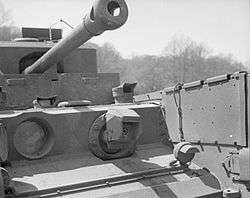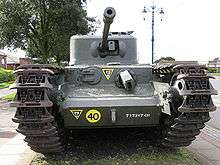Churchill Crocodile
The Churchill Crocodile was a British flame-throwing tank of late Second World War. It was a variant of the Tank, Infantry, Mk VI (A22) Churchill Mark VII, although the Churchill Mark IV was initially chosen to be the base vehicle.
| Churchill Crocodile | |
|---|---|
 A Churchill Crocodile firing its flame-projector | |
| Type | Infantry tank/Flame tank |
| Place of origin | United Kingdom |
| Service history | |
| In service | 1944-1945 |
| Used by | United Kingdom |
| Wars | Second World War Korean War |
| Production history | |
| Designed | 1944 |
| Produced | 1944 |
| Specifications | |
| Crew | 6 (commander, gunner, driver, radio operator/loader, flamethrower gunner, co-driver/hull gunner) |
| Armour | 152mm hull and turret front, 95mm hull sides and turret sides and rears, 51mm hull rear |
Main armament | Ordnance QF 75 mm |
Secondary armament | Flame thrower, 1 x coax Besa machine gun |
| Engine | See Churchill tank See Churchill tank |
| Fuel capacity | See Churchill tank |
The Crocodile was introduced as one of the specialised armoured vehicles developed under Major-General Percy Hobart, informally known as "Hobart's Funnies". It was produced from October 1943, in time for the Normandy invasion.
Design and development
From early in the war, there had been experiments with mounting flamethrowers on British vehicles; leading to vehicles such as the Cockatrice, Basilisk and the Wasp (the latter being a flamethrower on a Universal Carrier). The Churchill Oke, a flamethrower carrying Churchill Mark II developed by a Royal Tank Regiment officer, was tested operationally on the Dieppe Raid. Parallel development work was carried out by the Petroleum Warfare Department, AEC and the Ministry of Supply (MoS) on Valentine tanks. The Department of Tank Design preferred the Churchill, which was the Infantry tank successor to the Valentine, as a basis for further work.[1]
After General Percy Hobart saw the Crocodile demonstrated in 1943, he put pressure on the MoS to produce a development plan. The Chief of the General Staff added the flamethrowers to the 79th Division plan.[2]
Final design

The flamethrower equipment was produced as a kit that REME workshops could fit in the field, converting any available Churchill Mk VII. Although in practice field conversion was rarely done, if it was ever done at all, as it made more sense for the flame tanks to be allocated to designated units that had been specially trained to operate them.[3]
The conversion kit consisted of the trailer, an armoured pipe fitted along the underside of the tank, and the projector, which replaced the hull mounted Besa machine gun. The Crocodile was therefore still able to function as a gun tank with its turret mounted Ordnance QF 75 mm gun. The kit could also fit the Churchill Mk VIII, which was identical to the Mk VII except it was fitted with a 95 mm howitzer instead of a 75 mm gun; a very small number were converted to Crocodiles.[3]
Of the 800 kits produced, 250 were held in reserve for possible operations against the Japanese.[4] The remainder was sufficient for producing three regiments of tanks as well as training and replacements for battlefield casualties.
The Crocodile's six and a half ton armoured trailer carried 400 imperial gallons (1,800 l) of fuel[5] as well as five cylinders containing compressed gas propellant.[Note 1] This was enough for eighty[6][7] one-second bursts. Filling the trailer was laborious work and was usually done from standard 45-gallon drums. To make the task easier, it was common to construct an elevated structure of scaffolding poles that allowed the drums to be rolled out of the truck that delivered them, to directly over the trailer so the fuel could be poured straight in.[8]
The trailer, connected to the tank by a three way armoured coupling,[Note 2] and could be jettisoned from within the tank if necessary. The trailer's armour could resist small-arms fire, but would be penetrated by heavier weapons. Therefore, in action, Crocodile crews used their tank to shield the trailer from enemy fire as best they could.[8]
For transport over long distances, Crocodile units were issued with AEC Matador lorries to tow the trailers. The tanks themselves would be moved on tank transporters.[8]
Flame projector

The thrower had a range of up to 120 yards (110 m),[9] although some sources quote 150 yards (140 m).[10][11]
To ignite the flame, the projector used a fine spray of petrol from the Crocodile's main fuel tank, this was ignited by a spark plug, and in turn ignited the main fuel jet. The operator could spray long or short bursts of flaming fuel onto the target. The operator could also spray the target with unignited fuel, then set it on fire with a short, lit burst.[12]
Refuelling took at least 90 minutes and pressurization around 15 minutes; the pressure required had to be primed on the trailer by the crew as close to use as feasible, because pressure could not be maintained for very long. The fuel was projected at a rate of 4 imperial gallons (18 l) per second. The fuel burned on water and could be used to set fire to woods and houses.
Service
Used by units of the 79th Armoured Division in concert with the Churchill AVRE, and other Funnies, the Crocodile was an effective assault weapon whose threat could induce enemy troops to retreat or surrender. The Crocodile was a specialised weapon limited by the short range of its flamethrower. On the other hand, it was used so successfully against bunkers that many surrendered after the first ranging shots. Aspects of the mechanism were considered by the British to be so secret that disabled units, if they could not be recovered, were rapidly destroyed by any means, even air strike, if necessary.[13]
British Crocodiles supported the U.S. Army in the Normandy bocage, at the Battle for Brest, and during Operation Clipper, the Anglo-American assault on Geilenkirchen. C Squadron also supported the 53rd (Welsh) Division assault on 's-Hertogenbosch in October 1944.
The units that used the Crocodile in North west Europe, generally as part of 31st Armoured Brigade, were:
- 1st Fife and Forfar Yeomanry
- 141st Regiment Royal Armoured Corps (The Buffs, Royal East Kent Regiment) - 13th Troop, C Squadron saw action on the first day of the Normandy invasion.
- 7th Royal Tank Regiment
The flame projector was a powerful psychological weapon, so feared by the Germans that captured Crocodile crews were often summarily executed.[14][15]
In Italy, the 25th Armoured Assault Brigade operated Crocodiles.[16]
From late 1950 until their withdrawal in 1951, Churchill Crocodiles served in Korea as part C Squadron, 7th Royal Tank Regiment in 29th Brigade.
Other tanks
It was proposed that the Crocodile system be adapted for use with the M4 Sherman tank by US forces. The British undertook to supply 100 conversion kits to the Americans prior to D-Day and a prototype Sherman Crocodile was constructed, but American interest in the system wained and they adopted an American-developed flame variant of the Sherman. In combat this performed poorly and American interest in the Crocodile was revived.[17] Four Sherman Crocodiles were supplied to the US 739th Tank Battalion.[18] They were used only once, during Operation Grenade, against the heavily defended, 13th-century citadel in the town of Jülich. After heavy use of both their flame-projecters and their main guns, the tanks were able to force the German defenders to abandon the fortress.[19]
Post war, towing trials over an obstacle course were conducted using a Crocodile trailer and a Comet tank. But the trailer coupling broke and the work went no further.[20]
Surviving vehicles

Mark VII Crocodiles are owned by the Muckleburgh Collection in Norfolk, the Cobbaton Combat Collection in Devon, Eden Camp Museum in North Yorkshire, the D-Day museum in Portsmouth, the Wheatcroft Collection, the Kubinka Tank Museum in Russia and the Museum of the Regiments, Calgary, Alberta. A Mark VIII is at the Royal Australian Armoured Corps Museum. Two (one in running order) are privately owned in the UK. One in running order is under private ownership in the USA.[21] Another in running order is on display at the American Heritage Museum in the USA. One example without a trailer is on display at the Bayeux Museum of the Battle of Normandy. Another example with a trailer is held at the Bovington Tank Museum. Another, complete with a trailer, is on display on Fort Montbarey parade ground in Brest (Brittany); it was given as a Memorial by Queen Elizabeth II.
Notes
- Footnotes
- Initially compressed air was used, but later the preference was to use compressed nitrogen. See Fletcher (2007), p.16 and p,23
- The coupling coped with Yaw, pitch, and roll of the trailer with respect to the tank
- Citations
- Fletcher, (2007) p.12
- Churchill's secret weapons p 71
- Fletcher, (2007) p.21
- Churchill's secret weapons, p. 72
- The Encyclopedia of Tanks and Armored Fighting Vehicles - The Comprehensive Guide to Over 900 Armored Fighting Vehicles From 1915 to the Present Day, General Editor: Christopher F. Foss, 2002
- Fortin, Ludovic. British Tanks In Normandy, Histoire & Collections. ISBN 2-915239-33-9
- Fowler, Will. D-Day: The First 24 Hours, Lewis International Inc. ISBN 1-930983-22-0
- Fletcher, (2007) p.23
- Fowler gives a range of 80-120 m (73-110 yards), Fortin gives a range of 70-110 m (64-100 yards)
- How We Blasted the Huns with Flame in France, The War Illustrated, 29 September 1944
- "Equipment used by the Armoured Brigades". Archived from the original on 5 April 2007.
- Fletcher, (2007) p.18
- Wilson, A., 'Flame Thrower', William Kimber & Co Ltd, 1956
- Doherty, Richard (2004). Normandy 1944: The Road to Victory. Spellmount. p. 46. ISBN 1862272247.
- Robert J. Kershaw (1994). D-day: Piercing the Atlantic Wall. Naval Institute Press. p. 234. ISBN 1557501513.
- Crow, D Tanks of World War II 1979
- Fletcher, (2007) p.33
- Fletcher, (2007) p.34
- Nash, Mark (3 February 2018). "Sherman Crocodile". Tank Encyclopedia. Retrieved 11 August 2019.
- Fletcher, (2007) p.40
- http://www.toadmanstankpictures.com/churchill_crocodile.htm
References
- Delaforce, Patrick (2006). Churchill's Secret Weapons: the story of Hobart's Funnies. Barnsley: Pen & Sword. ISBN 1-84415-464-5.
- Fletcher, David (2007). Churchill Crocodile Flamethrower. Wellingborough: Osprey Publishing. ISBN 978-1-84603-083-3.
External links
- Equipment used by the Armoured Brigades
- Photos of the D-Day Museum Crocodile
- walkround of Crocodile
- Churchill Crocodile Flame-throwing Tanks (Part 1) (Film). Imperial War Museum. 1944. Film number A70 135-7.
- Churchill Crocodile Flame-throwing Tanks (Part 2) (Film). Imperial War Museum. 1944. Film number A70 135-8.
- Training With Churchill Crocodile Flamethrowing Tanks (Part 1) (Film). Imperial War Museum. 1944. Film number A70 11-1.
- Training With Churchill Crocodile Flamethrowing Tanks (Part 2) (Film). Imperial War Museum. 1944. Film number A70 11-2.